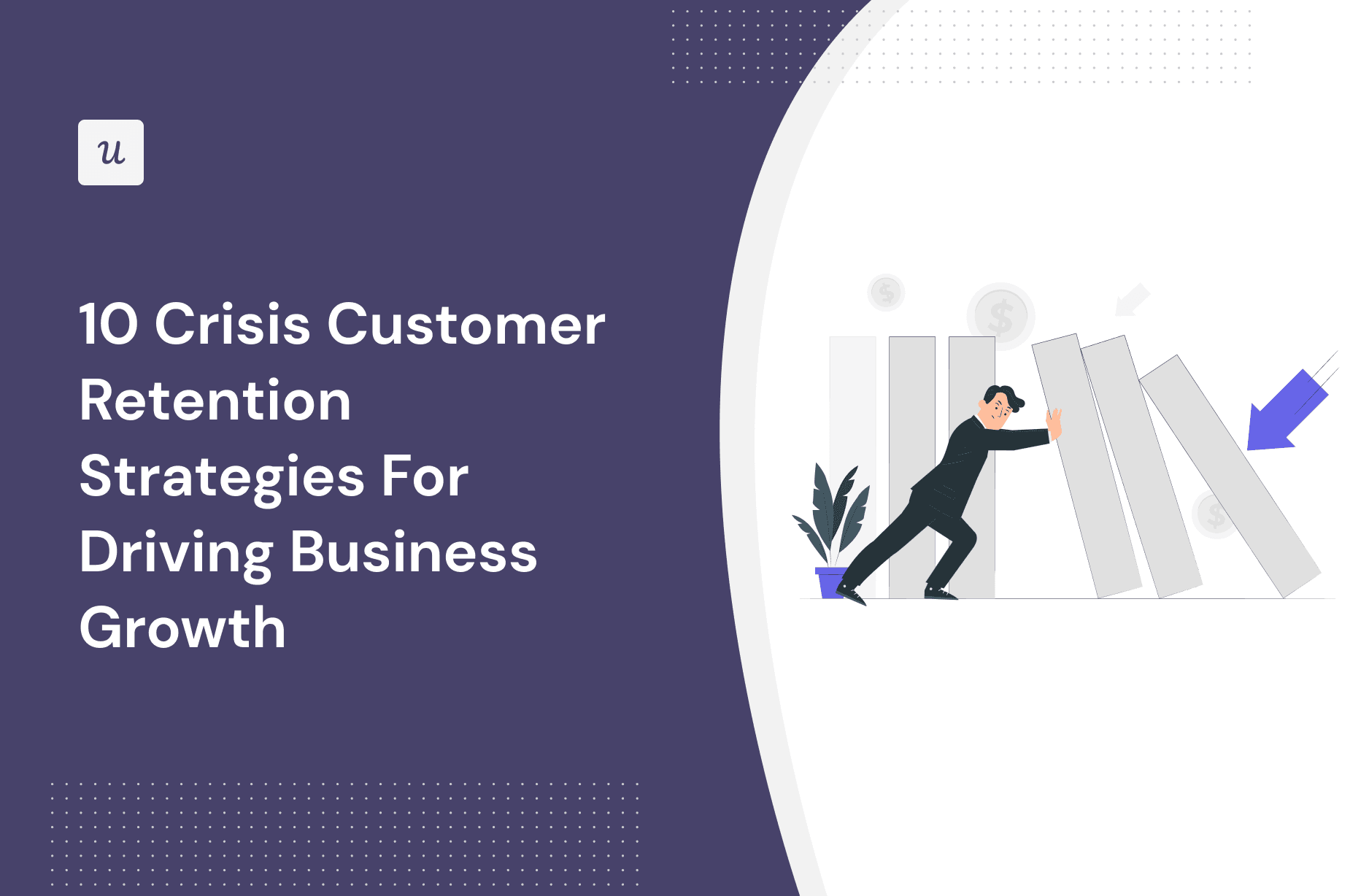10 Crisis Customer Retention Strategies For Driving Business Growth

Customer retention is hard enough at the best of times, so what chance does a business have of retaining their customers during times of crisis?
This guide will walk you through what crisis customer retention is, why it’s important, and strategies to increase retention across your customer base!
TL;DR
- Crisis customer retention is the product/business’ ability to retain customers during periods of crisis.
- Retaining customers helps you generate recurring revenue, drive loyalty, and increase customer lifetime value.
Here are 10 ways to increase customer retention:
- Personalized onboarding. Personalizing the customer journey for new customers according to their pain points will increase onboarding engagement.
- Product demos. Even though 1-on-1 product demos are time-consuming, they increase product adoption and retention rates by offering personalized support.
- Self-service support. In-app resource centers and other self-service options give users the ability to solve problems themselves and improve customer satisfaction.
- Contextual help. Tooltips, modals, and other UI patterns are great ways to provide in-app guidance at the moments when they’re needed most and improve customer experience.
- User communities. Creating Facebook groups, Slack workspaces, LinkedIn communities, or online forums around your product will help users interact and help each other out.
- Loyalty programs. Rewarding existing customers for their loyalty and advocacy will incentivize referrals while reinforcing their decision to stay with your business.
- Feedback collection. Gathering feedback from your customers will help you identify recurring problems and fix them.
- Behavioral analytics. Looking at the product usage patterns of your happy customers will help you identify the commonalities between which features they use or the paths they take.
- Funnel analysis. Conducting funnel analysis will help you spot the steps most users get stuck on by comparing the drop-off rates between each stage.
- Churn surveys. Cancellation surveys can be both a feedback collection mechanism and a last line of defense to stop users from canceling their subscriptions.
- Want to get started with your retention strategy? Book a demo with Userpilot and learn how we can help you retain customers with contextual in-app experiences.
What is crisis customer retention?
Crisis customer retention is the ability of a product or business to retain its customers during periods of crisis. High crisis retention rates result in customers who continue to purchase from the company even in times of crisis.
Why is retaining customers important for SaaS companies?
There are a few key reasons why you should focus on retaining existing customers:
- Recurring revenue. Getting repeat customers to drive recurring revenue is the foundation of the SaaS business model.
- Building trust. Building trust with your customers will foster a sense of brand loyalty that ensures repeat business keeps coming back to you instead of switching to competitors.
- Lifetime value. When you increase LTV, you also accelerate your revenue growth rate and create a more sustainable model that’s built on effective retention strategies rather than rapid acquisition.
How to drive customer retention among the existing customer base
Saying that you’ll build brand loyalty and keep customers for longer is easier said than done.
The sections below will walk you through 10 ways to increase customer retention rates and identify customers who may be at risk of churning!
Create a personalized customer journey to activate new customers
Understanding a user’s job-to-be-done (JTBD) through a welcome survey will help you personalize the onboarding experience from the get-go.
Users will be more likely to engage with in-app flows that are relevant to their use case.
This customer activation funnel is all about making a good first impression, holding the user’s attention with relevant in-app guidance, and getting them to experience the value the product offers as soon as possible.

Drive customer success with 1-on-1 demos
For more complex products, it’s a good idea to allow new users to hop on a demo call with customer success managers who can help them set the software up, explain the core features, and better understand their goals.
These product demos and white-glove onboarding measures may be time-consuming due to their high-touch nature, but they’re also highly effective at increasing customer retention.
If you’re already offering demos, make sure your users know about it by publishing in-app demo invitation modals:

Improve customer satisfaction with self-service options
The majority of SaaS users prefer self-service, so they don’t need to wait in the support queue until a representative is available to speak with them.
This preference for self-serve models extends beyond the world of SaaS. The Harvard Business Review found that 81% of customers try to solve problems themselves before reaching out to a support representative.
Because preference leads to expectation, you must be able to meet user expectations by building a self-service infrastructure around your product.
This could consist of self-service portals that direct customers to multimedia resources in different formats or an in-app resource center that makes this information available from within the software application itself.

Offer contextual help with tooltips to improve customer experience
Whenever one of your users abandons a workflow without achieving the goal they had upon initiating it, you should trigger an in-app message that reduces friction and gets them back on the right path.
This type of contextual help can help mitigate user friction and avoid escalation amidst moments of crisis.
Here’s a tooltip example that redirects users toward interactive walkthroughs whenever they fail to accomplish a task or use a feature:
In this sense, contextual help is like an automated form of proactive communication.

Create a customer community on social media
Build a digital space that’s exclusively available to your customers. This gives users a central point to receive help from other people who have used the product and may have experienced similar challenges.
In addition to democratizing access to support, it also provides a sense of community for your customers and improves brand perception.
A prime example of this is the Product Marketing & Growth Facebook group that Userpilot has built up over the past few years.

Create a customer loyalty program to strengthen customer relationships
Customer loyalty programs are a great way to strengthen relationships, create advocacy, and increase the positive word-of-mouth reach of your brand.
These programs not only drive retention but can also create an acquisition flywheel for your business.
To encourage customers to refer colleagues to your product, advocacy should be incentivized and rewarded to create a win-win scenario for everyone involved.
The referrer should get exclusive rewards, the referee should get a discount, and the company will end up with more (and happier) customers.

Collect customer feedback to improve your customer retention strategy
Having customer feedback systems in place that gather actionable insights from your users is crucial since you can’t improve retention if you don’t know what’s causing churn in the first place.
The best way to collect targeted feedback is through in-app NPS surveys.
Listening to feedback from detractors and seeing how the Net Promoter Score changes over time will help you predict the trajectory of churn rates while simultaneously tracking the issues that are causing that churn.
As a bonus, you can also use detractor responses to win customers back if they churn after responding.

Track the behavior of loyal customers and replicate their paths
Analyzing the product usage patterns of power users can give you a clearer idea of which features drive the most value and which events lead to conversions.
Once you’ve identified the paths that power users took, you can put other users (with similar traits and goals) on the same path through in-app guidance.

Use funnel analysis to identify drop-off points and fix them
Churn prevention is just as much about seeing where users fail (drop-off points) as it is about seeing where they succeed (power users).
Monitoring the user journey can be a good starting point to identify friction points, but you should delve deeper by reviewing screen recordings or conducting interviews.
Conversion funnel analysis is the most straightforward way to diagnose the problem so you can start fixing it before the rest of your user base starts churning. Our funnel charts show you the exact drop-off rates between each step of your funnels:

Optimize your offboarding flow to retain customers on the verge of churn
Last but not least, it’s important to realize that cancellation surveys can also serve as churn-reduction mechanisms.
Here is how that would work:
When users click the “cancel” button, trigger a churn survey to understand the reason behind their decision. Based on their response, offer a compelling alternative to win them back.

For example, in Asana’s offboarding flow, users are offered to downgrade their accounts if their primary reason for canceling is money.

Conclusion
As you can see, it’s still possible to retain customers even when they’ve failed to use a feature or were about to cancel their subscription. It all comes down to identifying what the problems are through customer surveys and data analysis.
If you can figure out what the problem is, you’re one step closer to solving it.
Ready to increase retention rates through in-app guidance and feedback collection? Get your free Userpilot demo today!


